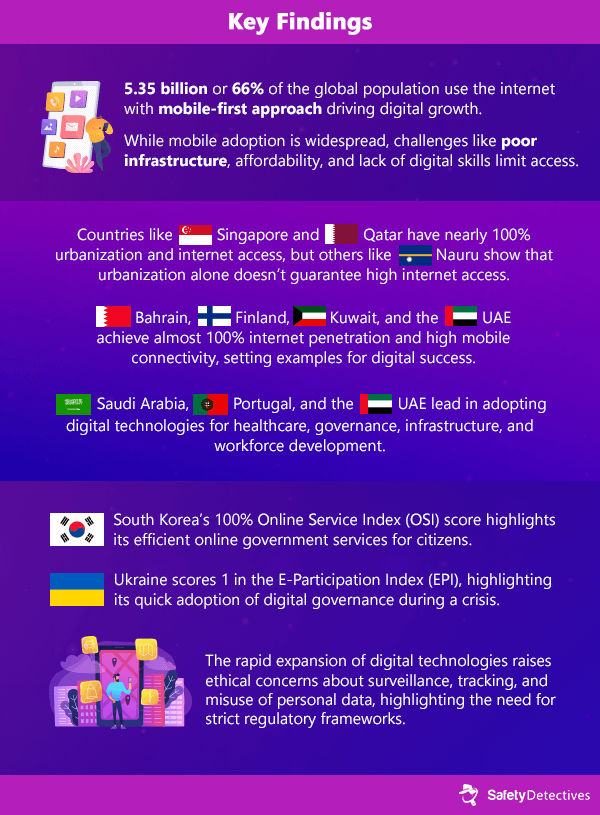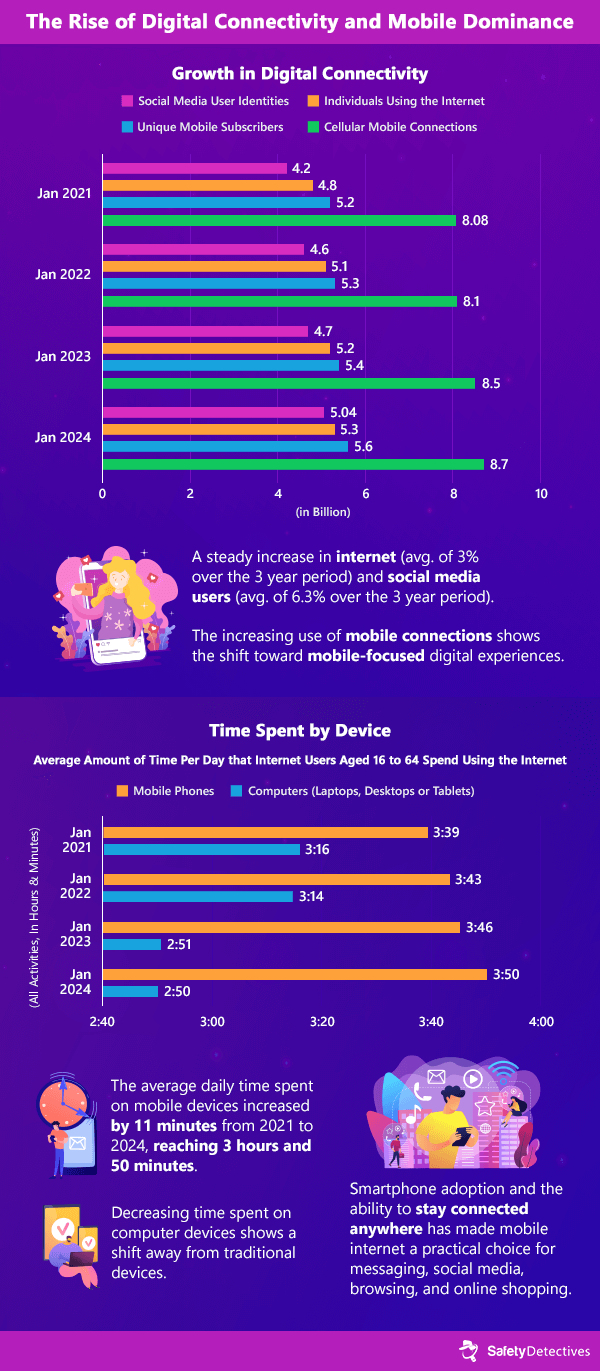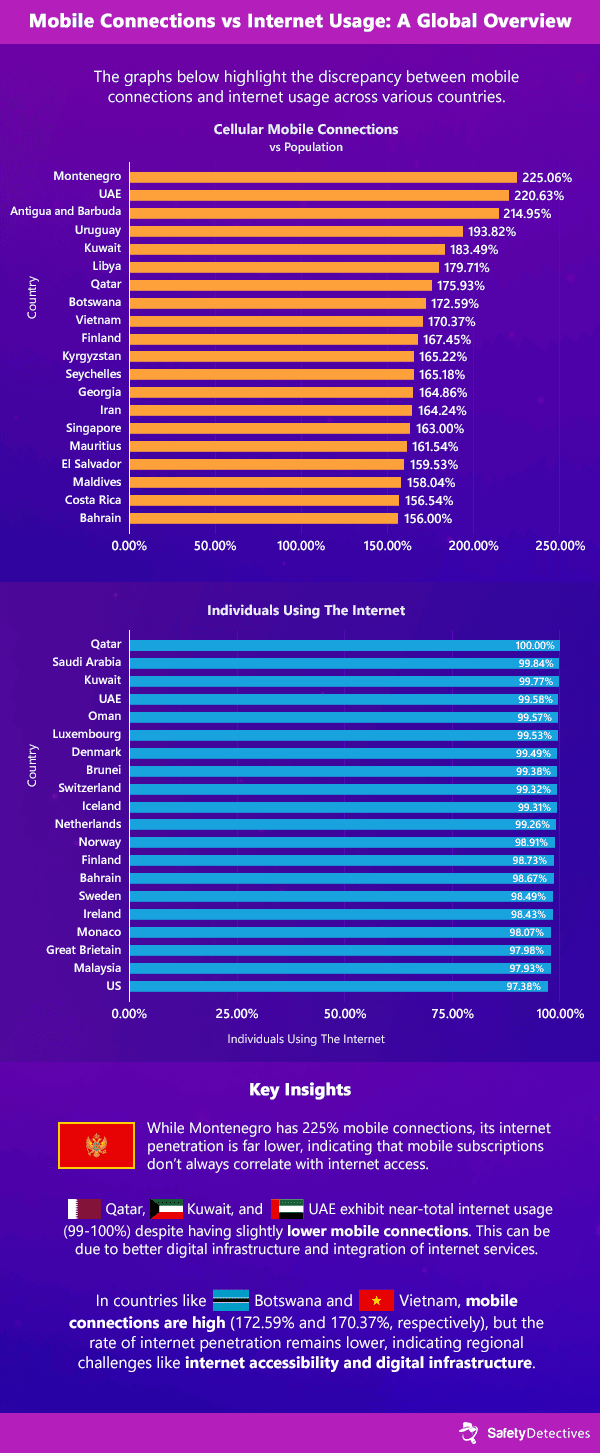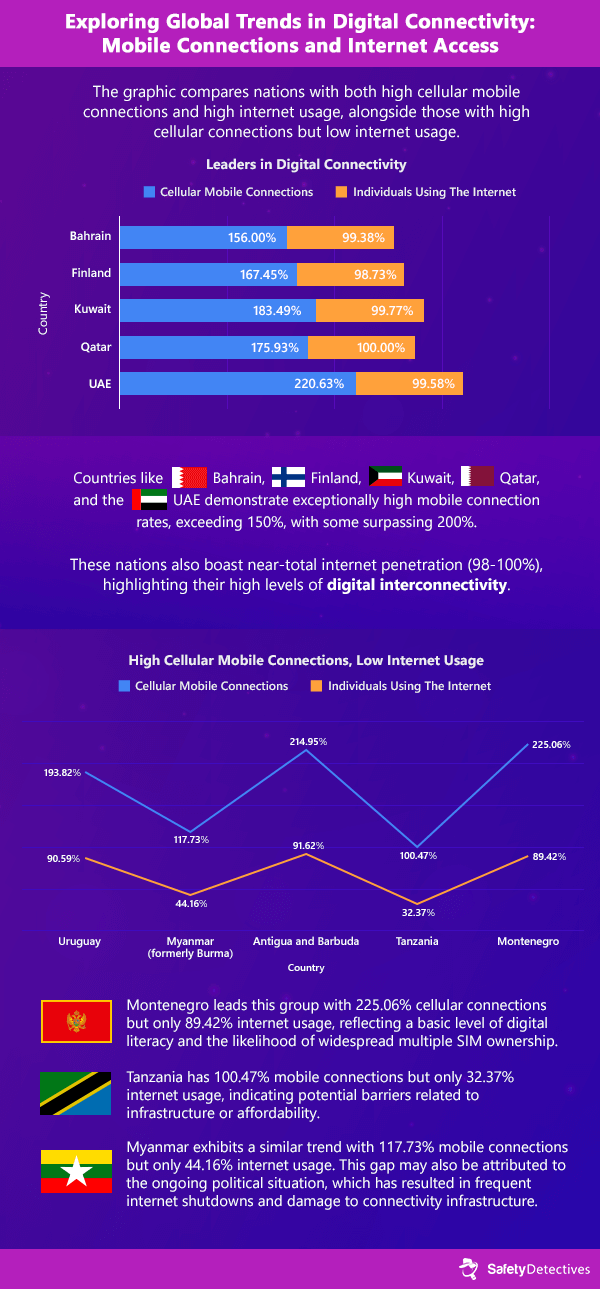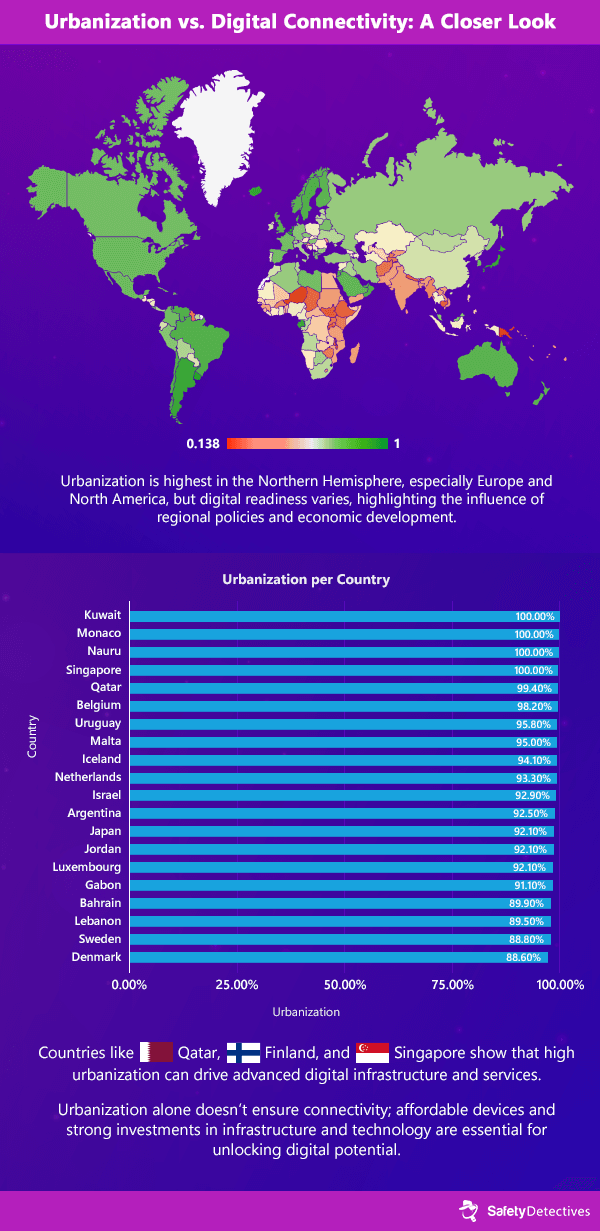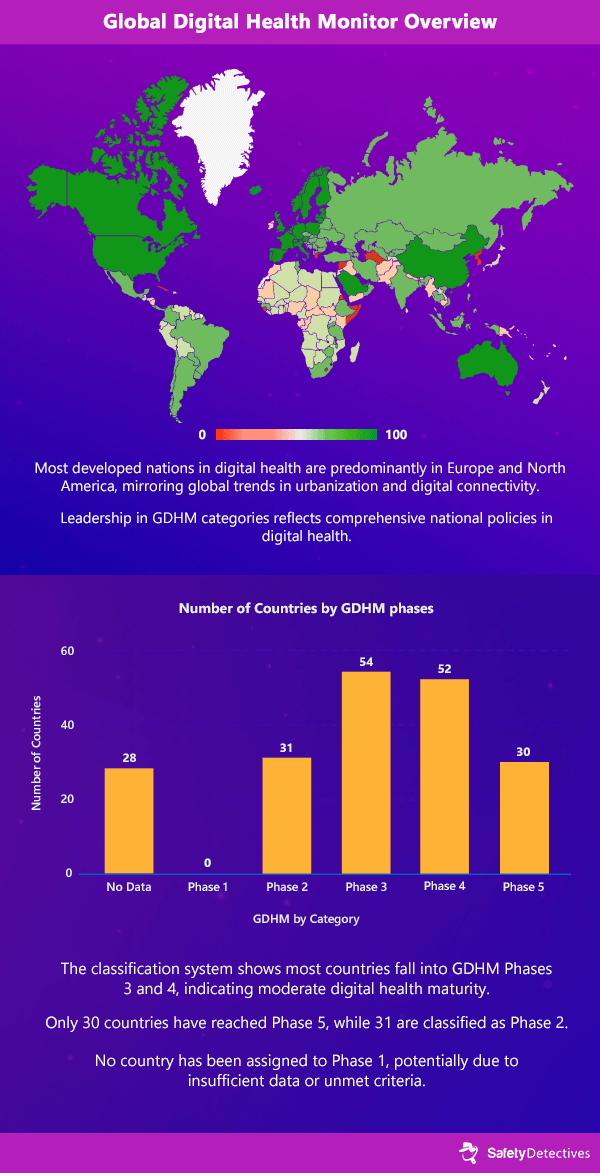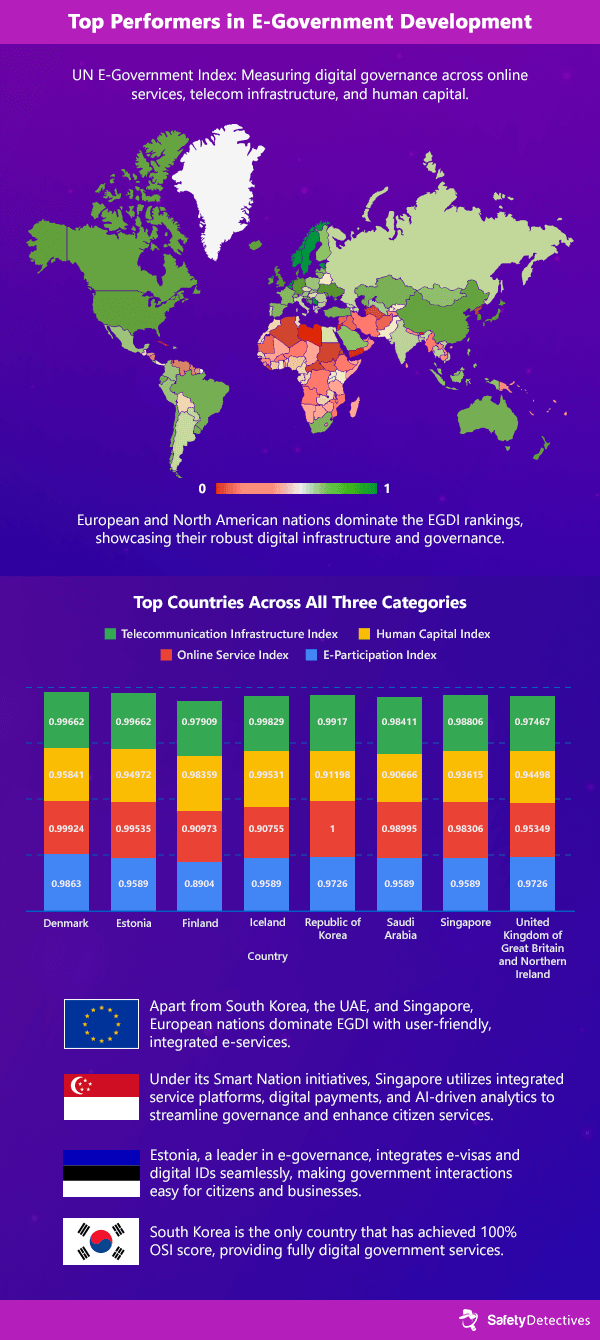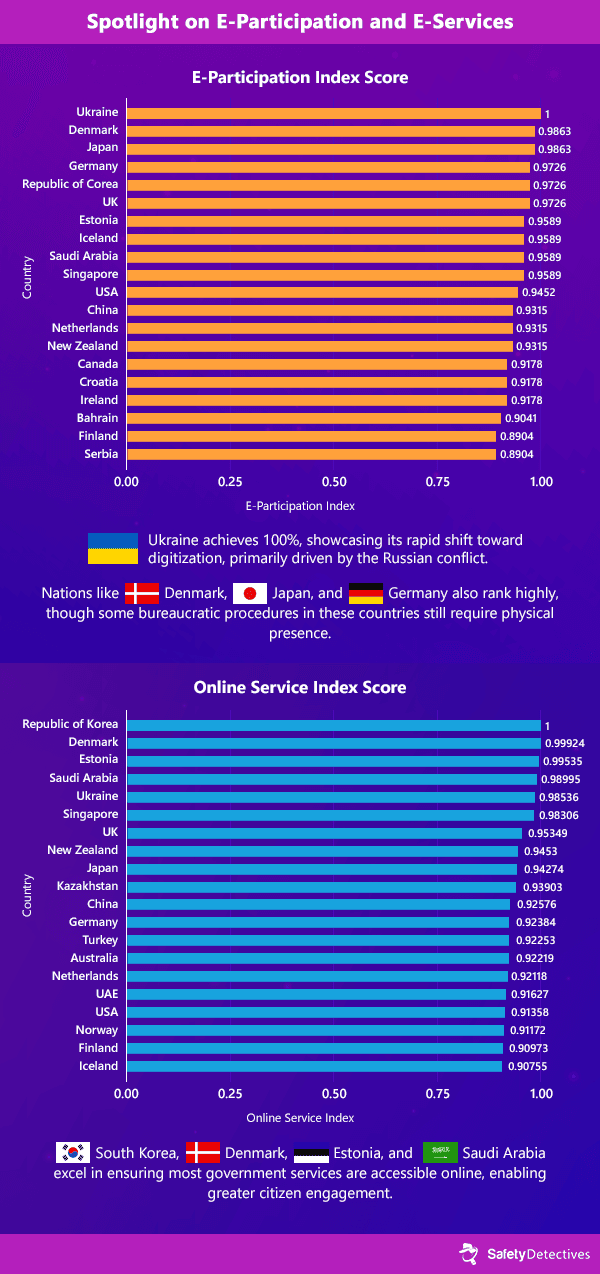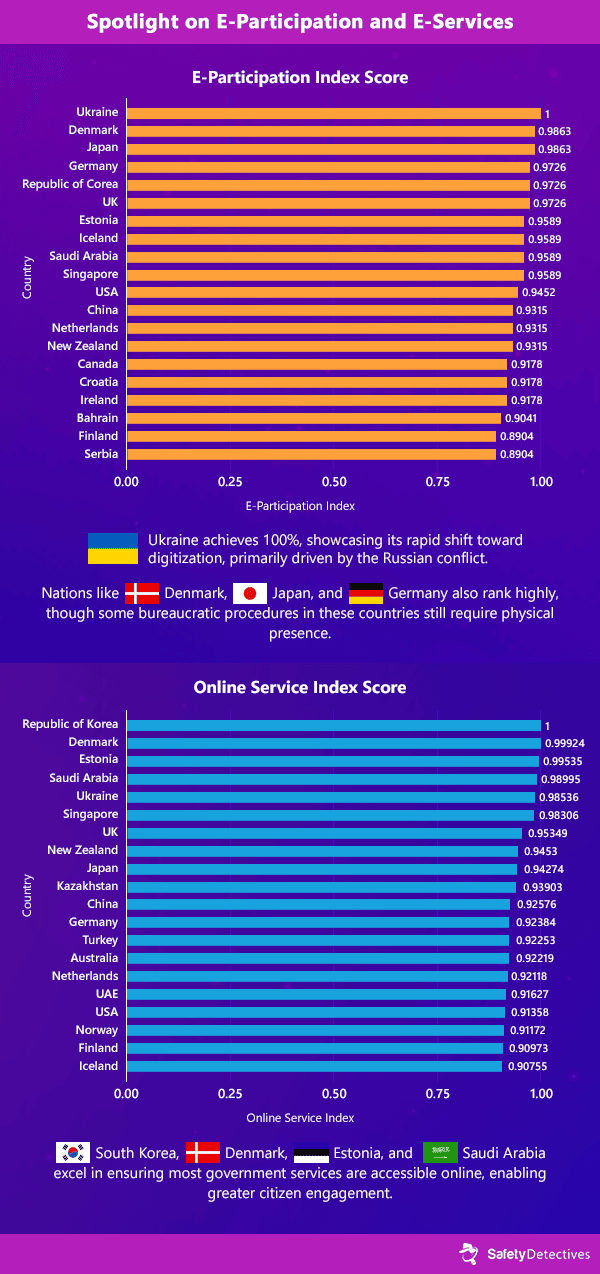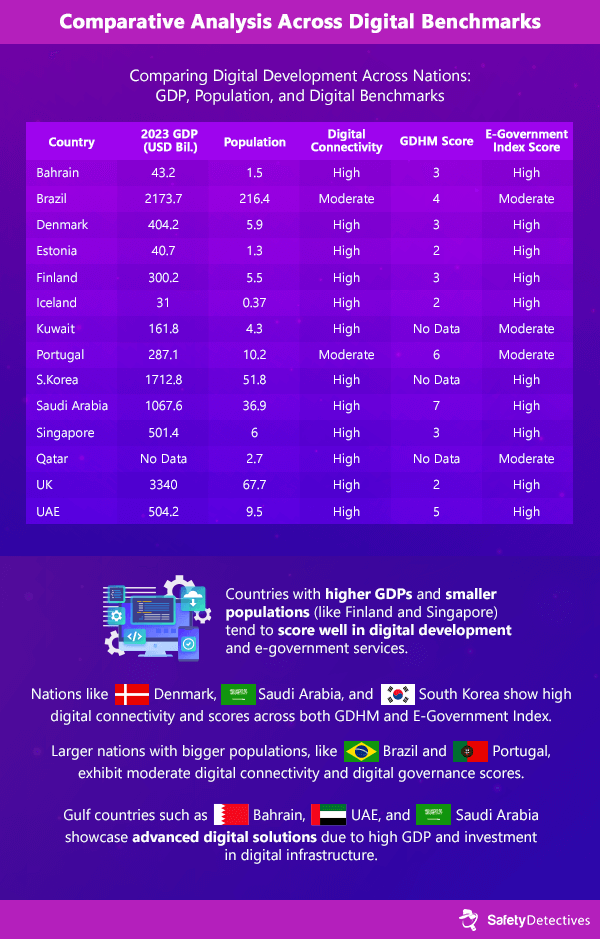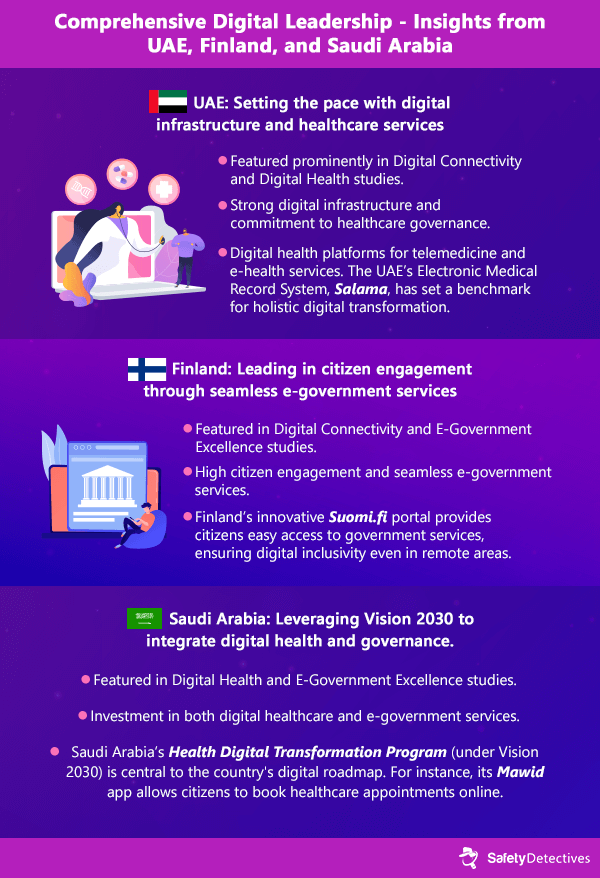
Shipra Sanganeria
Published on: January 16, 2025
The global shift toward digitalization is transforming how nations govern, connect citizens, and deliver healthcare by enhancing citizen engagement, revolutionizing healthcare systems, and streamlining governance through integrated e-services.
Aligned with Safety Detective’s focus on data-driven global insights, this research examines three areas of digitalization: connectivity, digital health, and e-government, using insights from DataReportal, the Global Digital Health Monitor (GDHM), and the UN E-Government Index. These metrics highlight critical areas of digital interconnectivity: mobile infrastructure, health-related services, and the extent of government influence on citizens’ lives.
The article explores how top-performing countries in digitalization serve as models for integrated digital services, highlighting the transformative potential of digital tools and technologies, while also presenting cautionary tales that highlight the importance of carefully considering privacy and data security.
Global Connectivity Overview
Digital connectivity is transforming how people and governments access and distribute information, interact both internally and externally, and conduct business.
According to DataReportal and GSMA Intelligence, worldwide, 5.35 billion people (66% of the global population) use the internet, while 5.61 billion (69.4%) individuals are mobile subscribers, highlighting a growing shift toward mobile-first connectivity. However, regional disparities in digital infrastructure persist due to economic, geographic, and policy factors, influencing the pace of digital adoption across regions.
This section explores the rapid growth of digital connectivity which has been driven by rising internet usage, mobile adoption, and urbanization.
Global Trends in Digital Connectivity
The graphic below illustrates a steady increase in global digital connectivity between 2021 and 2024. Driven by the growing adoption of mobile technology, key metrics such as internet users, social media users, unique mobile subscribers, and cellular connections have consistently increased year after year.
For instance, social media users grew from 4.2 billion in 2021 to 5.04 billion in 2024, while unique mobile subscribers rose from 5.2 billion to 5.6 billion during the same period. Cellular connections also saw a notable increase, reaching 8.7 billion in 2024.
Notes: According to GSMA Intelligence, there is a significant distinction between unique mobile subscribers and mobile connections. A unique mobile subscriber refers to one individual who subscribes to mobile services, whereas mobile connections represent the total number of SIM cards registered on mobile networks, meaning a single subscriber can have multiple connections.
The shift toward mobile-first internet usage is clear, with people spending more time on mobile devices than on traditional computers. Average daily mobile usage increased from 3 hours 39 minutes per day in 2021 to 3 hours 50 minutes in 2024, while time spent on laptops and desktops declined from 3 hours 16 minutes to 2 hours 50 minutes during the same period.
The shift is largely driven by the affordability and accessibility of mobile devices, especially when compared to laptops and desktops. Additionally, the dominance of mobile technology is further strengthened by platforms like social media, e-commerce, and entertainment services, which are specifically optimized for mobile users.
Despite challenges such as affordability (especially for handsets), literacy, and digital skills (GSMA State of Mobile Internet Connectivity Report 2024), mobile adoption remains robust, with mobile broadband subscriptions projected to grow at a compound annual growth rate (CAGR) of 3% between 2024 and 2030, reaching 9.07 billion by the end of 2030 (Ericsson’s Mobility Report).
Leaders in Mobile and Internet Connectivity
While mobile connections are growing rapidly worldwide, they don’t always correlate with high levels of internet usage. The graphic below highlights the gap between mobile connectivity and internet adoption across various countries.
High cellular mobile connections often result from factors such as multiple SIM ownership, limited digital literacy, the cost of internet-enabled devices or data plans, and a reliance on traditional mobile services like voice calls and SMS. These factors together emphasize that having more mobile connections doesn’t necessarily guarantee widespread internet usage or accessibility. To ensure universal access, further work is needed to make internet services accessible and affordable for all.
However, some countries such as Bahrain, Finland, Kuwait, and the UAE set a benchmark for achieving both high mobile connection rates and near 100% internet penetration. These countries demonstrate how advanced infrastructure, favorable socio-economic policies, and a focus on technology adoption can create robust digital ecosystems that help integrate mobile technologies into daily life.
On the other hand, countries like Myanmar face significant challenges in leveraging internet connectivity. Political instability, frequent internet shutdowns, and infrastructural damage hinder their ability to capitalize on digital advancements. Similarly, countries like Tanzania, despite widespread mobile access, struggle with internet access due to infrastructural and socio-economic challenges.
The Role of Urbanization in Connectivity
Urbanization is often associated with better internet access and advanced digital infrastructure, but the data presents a different reality. While countries like Qatar and Singapore boast nearly 100% urbanization alongside near total internet usage (99-100%), others, such as Nauru and Gabon, despite being fully urbanized, do not rank among the top countries for digital connectivity.
Note: The map illustrates the urbanization levels across various countries, 100% represents complete urbanization (100% of the population resides in urban areas) and 0 signifies no urban population.
As illustrated in the graphic above, countries in the Northern Hemisphere, particularly in Europe and North America, exhibit some of the highest urbanization rates. However, this measure reflects the proportion of the population living in urban areas, not their access to education, communication infrastructure, or digital amenities.
For example, countries like Singapore, Qatar, and Monaco report nearly 100% urbanization. Yet, this does not automatically translate into universal digital connectivity or advanced infrastructure for all residents. The degree of digital interconnectivity — defined by access to the internet, mobile networks, and other digital resources — requires further evaluation.
Top Performers in the Global Digital Health Monitor (GDHM)
The Global Digital Health Monitor (GDHM), launched at the World Health Assembly in May 2023) is an interactive tool designed to track, monitor, and evaluate the use of digital technology in healthcare systems across countries.
By tracking progress across seven key categories — Leadership & Governance, Strategy & Investment, Legislation & Compliance, Workforce, Standards & Interoperability, Infrastructure, and Services & Applications — the GDHM offers insights into digital health maturity.
Countries are classified into five phases, from Phase 0 (Early Stage), Phase 1 (Initial Stage), Phase 2 (Developing Stage), Phase 3 (Advanced Stage), Phase 4 (Leading Stage), and Phase 5 (Pioneering Stage), offering a framework to assess the readiness, and guide policymakers and stakeholders, to improve the digital health system.
The graph below illustrates the overall classification of countries.
Among the countries in the report, some stand out across multiple GDHM categories, highlighting their all-encompassing approach to digital health.
While digital technologies like interoperable e-health records and digital platforms improve healthcare accessibility and efficiency, they also raise ethical concerns, especially regarding data privacy and misuse. Countries must establish strong legal frameworks to protect patient information and prevent surveillance, while encouraging innovation.
E-Government: Leaders in Digital Governance
The E-Government Development Index (EGDI), launched by the United Nations (UN)), is a composite index for assessing how effectively governments leverage digital technologies to deliver public services, ensure transparency, and engage citizens. Updated every two years, the EGDI evaluates countries across three components:
- Online Service Index (OSI): Measures the availability and user-friendliness of government online services.
- Telecommunications Infrastructure Index (TII): Assesses internet penetration, broadband access, and mobile connectivity.
- Human Capital Index (HCI): Evaluates digital skills and literacy levels, essential for engaging with e-government services.
Countries are scored on a scale from 0 to 1 across these components, with classifications ranging from Phase 1 (low development) to Phase 5 (very high development). This index helps track e-government initiatives, identify gaps, and promote universal digital inclusion.
Spotlight on E-Participation and Online Service Indices
In terms of scoring: for EPI, a score of 1 indicates full citizen engagement in government services online, while a score of 0 means no participation. In contrast, for OSI, 1 means that all government services are accessible, while a score of 0 means that citizens must access services in person.
Ukraine scores 1 in EPI, reflecting its rapid digital transition driven by ongoing conflict, enabling citizens to engage with the government without physical contact. South Korea leads with a 100% OSI score, offering full online accessibility for all government services, setting a benchmark for e-government services.
Telecommunications and Human Capital Leaders
In terms of scoring: for the TII (Telecommunications Infrastructure Index), a score of 1 indicates robust government telecommunications infrastructure, while 0 indicates its absence. For the Human Capital Index (HCI), 1 signifies necessary skilled personnel for communication technologies, while 0 indicates a lack of qualified staff within the government.
The UAE leads in telecommunications infrastructure, and Australia sets the standard in human capital, highlighting essential pillars of effective e-governance.
Comparative Analysis Across Indices
Analyzing the correlation between GDP, population size, and the scores in the UN E-Government Index, GDHM, and other key digital benchmarks reveals that wealthier nations and those with smaller populations tend to develop and implement digital solutions more effectively.
These nations tend to showcase strong digital infrastructure and advanced e-government services, supported by policies supporting high digital connectivity.
High digital connectivity plays an important role in the advancement of e-government services, as seen in countries like Singapore and South Korea. Their success highlights the role of robust infrastructure and policy alignment, and strategic investment in fostering efficient digital solutions. Smaller populations also make it easier to scale and implement digital initiatives effectively.
However, the data also highlights the unique challenges faced by larger nations like Brazil and Portugal. Despite economic resources, these countries often face challenges in scaling their digital infrastructure. Strategic investments, targeted national policies, and regional approaches are necessary to help unlock the full potential of digital connectivity.
Countries with moderate digital connectivity, such as Portugal and Kuwait, have great potential for improvement. By building on their current systems and investing in technology and education, they can strengthen their digital ecosystems.
In conclusion, the future of digital connectivity depends not just on GDP or population size but also on a country’s ability to adapt to new technologies and national policies promoting digital inclusion.
Case Studies of Digital Excellence and Innovation
Although no country appears at the top across all these digital benchmarks, a few stand out for their comprehensive digital leadership. The UAE, Finland, and Saudi Arabia demonstrate how integrating these digital elements can lead to significant technological transformation.
The UAE is a prominent example, setting the pace with its strong digital infrastructure and healthcare services. The country’s investment in digital health platforms, including its electronic medical record system Salama, shows its commitment to both healthcare and digital connectivity.
Finland, on the other hand, leads in citizen engagement through its seamless e-government services. Its Suomi.fi portal provides citizens with easy access to a wide range of government services, ensuring digital inclusivity even in remote areas. The country’s focus on digital connectivity and e-government services highlights the role of digital platforms in creating an efficient governance system.
Together, these countries highlight the importance of a holistic digital strategy that includes infrastructure, healthcare, and e-governance.
In conclusion, we can say that countries that invest in all these areas are better positioned to create a more connected and efficient society. This interconnected approach to digital transformation could play a key role in shaping the future of governance globally.
Challenges of Digitalization: Surveillance and Privacy Concerns
Digitalization has helped countries achieve new levels of efficiency and connectivity, but also raised concerns about data privacy and surveillance. Across the globe, countries such as China, India, and the US have embraced digitalization including integrating artificial intelligence (AI) to improve governance and public services. However, these technologies often enable extensive surveillance, raising concerns about their ethical implications and individual privacy.
For instance, China’s Skynet system employs facial recognition and big data analytics to monitor public spaces. Similarly, France’s 2016 Big Data for Public Tranquillity Project and Seoul’s smart policing system, which employs AI-based cameras for crime prevention, highlight the growing use of AI in surveillance. While governments argue that these systems improve public safety and tackle security threats, citizens and critics remain wary of potential data misuse, bias against minorities, and the erosion of privacy.
Another growing concern is the rise in data breaches that affect millions of individuals globally. Governments rely on biometric systems to store citizens’ personal information, and a breach could expose sensitive data on a large scale. A notable example is India’s Aadhaar program, which collects biometric data from over 1.1 billion individuals. A major 2017 data breach exposed the weakness of large digital identity systems and raised concerns about potential misuse.
These cases highlight the challenges of digitalization, where technological progress needs to be matched with strong legislative and technological safeguards to protect privacy and potential misuse.
Methodology
This research analyzes digitalization across countries using three key sources: the Digital Insights report, the Global Digital Health Monitor (GDHM), and the UN E-Government Index.
First, we used the Digital Insights report to examine connectivity metrics such as mobile cellular connections, internet access, and the number of social media accounts. We specifically focused on urbanization, mobile usage, and internet penetration to compare how these factors influence connectivity across nations.
Next, we used the Global Digital Health Monitor (GDHM) to assess the integration of digital technologies in health services. The GDHM evaluates countries across seven categories, including governance, infrastructure, and services, offering insights into digital health and maturity.
Finally, we used the UN E-Government Index for its assessment of government digital services, by measuring each country’s online service provision, telecommunication infrastructure, and human capital, using a standardized methodology for global comparisons.
Together, these data sources offer a comprehensive view of how countries are advancing in digitalization across connectivity, healthcare, and governance.
Discussion
In conclusion, the global shift toward digitalization is transforming governance, connectivity, and healthcare, with countries leveraging technology to boost citizen engagement and streamline public services. Top performers like the UAE, Finland, and Saudi Arabia showcase an all-round approach, excelling in benchmarks such as e-government, digital health, and connectivity.
Digital advancements offer significant potential to improve quality of life. However, they also bring potential challenges, such as data misuse, surveillance, and privacy concerns. Addressing these issues through thoughtful policies as well as promoting equitable access will likely help shape the future impact of these technologies.




